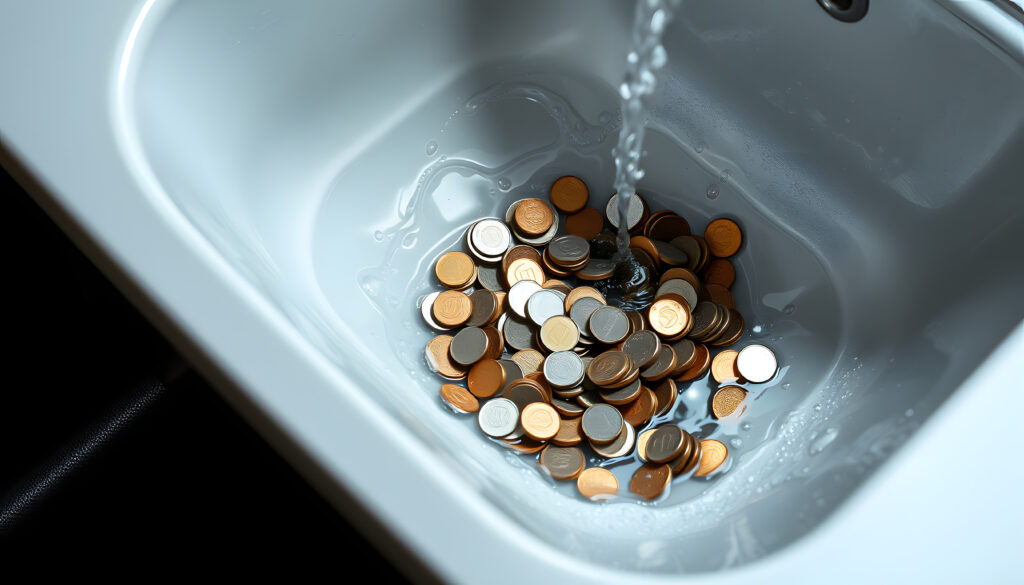
Why Is My Water Bill So High? Hidden Leaks & Other Possible Reasons
Opening your monthly water bill only to find an unexpectedly high charge can be shocking and frustrating. If you’re asking yourself “why is my water bill so high?” you’re not alone. Many homeowners face this common problem, and the causes aren’t always obvious. Keep reading to learn what’s behind your high water bill, plus how you can prevent future surprises.
5 Common Causes for High Water Bills
Let’s explore the most frequent reasons behind why your water bill is so high:
1. Hidden Plumbing Leaks
Silent leaks are often the most expensive and challenging problems to detect, quietly wasting hundreds of gallons of water while remaining completely hidden from view. Theses leaks include:
- Cracked or damaged pipes behind walls
- Underground pipe leaks in your yard
- Worn-out pipe joints and fittings
- Small cracks in your home’s foundation
- Deteriorating pipe seals
Other common hiding spots for leaks include worn-out pipe joints and fittings, which can develop small drips over time, and deteriorating pipe seals that slowly lose their effectiveness. Even seemingly insignificant cracks in your home’s foundation can harbor hidden leaks that contribute to water waste.
To put this in perspective, a single 1/8-inch crack in a pipe can waste an astounding 250 gallons of water per day, which is more than enough to fill a swimming pool within a couple of months.
2. Running Toilets
While a running toilet might seem like a minor nuisance, it’s actually one of the most significant sources of water waste in many homes. A properly functioning toilet should only run water briefly after flushing to refill the tank. However, when components start to fail, your toilet can quietly waste up to 200 gallons of water every day — that’s like taking over 13 extra showers every day!
Toilet issues that often result in high water bills include:
- Faulty flush valves
- Worn-out flapper seals
- Malfunctioning fill valves
- Improperly adjusted float mechanisms
- Cracked overflow tubes
Even a tiny crack in the overflow tube itself can lead to constant water waste. What’s worse, is the fact that toilet leaks are often silent, and can go unnoticed for months.
3. Dripping Faucets
A single faucet dripping at the rate of one drop per second — a drip so slow you might barely notice it — adds up to a staggering amount of wasted water over time. In just one day, such a drip wastes 8.64 gallons of water. Over a month, this increases to about 250 gallons, and across an entire year, a single dripping faucet can waste 3,000 gallons of water.
4. Irrigation System Problems
Your outdoor irrigation system can significantly impact your water bill, often in ways that aren’t immediately obvious. Underground leaks in irrigation lines can waste substantial amounts of water without showing visible signs at the surface.
These leaks often develop at joints or where pipes have been damaged by root growth or soil movement. Broken or misaligned sprinkler heads, while more visible, are frequently overlooked during routine yard maintenance. Even a single misaligned sprinkler head can waste hundreds of gallons by watering driveways or sidewalks instead of your lawn.
But here’s the kicker: even if your sprinklers are in good shape, your timer settings could be the real problem. Plenty of folks forget to tweak their sprinkler schedules when the seasons change or the weather gets wacky. Running those sprinklers during or right after a downpour? That’s a surefire way to inflate your water bill. And if you’re letting zones run too long or overlap, you’re not just wasting water — you’re drowning your grass!
5. Changes in Water Usage Patterns
Sometimes, a high water bill isn’t due to any malfunction but rather reflects changes in your household’s water consumption patterns. When new family members or long-term guests join your household, their daily activities like showering, laundry, and dishwashing naturally increase overall water usage. Similarly, installing new water-intensive appliances, such as a washing machine or dishwasher, can affect your water consumption, especially if they’re older, less efficient models.
Seasonal activities and home improvements can also drive up water usage. Recent landscaping projects often require additional watering during the establishment period for new plants and grass. Pool maintenance, including initial filling and regular top-offs due to evaporation, can consume thousands of gallons of water. Understanding these seasonal and lifestyle-related changes helps you better predict and manage your water consumption.
How To Identify the Cause of Your High Water Bill
Smart Water Meter Monitoring
One of the most reliable ways to detect hidden leaks is by carefully monitoring your water meter. Begin by ensuring all water-using appliances and fixtures in your home are turned off, including ice makers and water softeners. Jot down the number on your meter, then take a two-hour break from using any water at all. No flushing, no running faucets, and no automatic systems like sprinklers. After two hours, check the meter again. If the number has changed, bingo — you’ve got a leak.
Check Your Pipes for Signs of Damage
Take a good look at all the pipes you can see, especially around connections and joints where leaks like to hide. Check your faucet gaskets and pipe fittings for any signs of wear and tear. Don’t forget to look up, water stains or weird discoloration on your ceilings and walls could mean a hidden leak. And keep your ears open around toilets. Even a faint running sound could be a clue that you’re losing gallons of water every day.
Understanding Your Water Usage History
Your water bill can tell you a story if you know how to read it. Pull out your old bills from the same time of year and compare them to what you’re paying now. See if you can spot any big jumps that don’t make sense. Think about any changes in your home that might be bumping up your water use, like a new washing machine or an extra person living with you. And don’t forget about seasonal stuff, like watering your garden or filling up the pool all of these can explain a temporary spike in your bill.
Frequently Asked Questions About High Water Bills
Why is my water bill so high all of a sudden?
A sudden spike in your water bill typically indicates either a leak, a malfunctioning appliance, or a significant change in water usage patterns. Common causes include hidden plumbing leaks, running toilets, dripping faucets, or seasonal changes in water use. A professional plumbing inspection can help identify the specific cause of your increased bill.
Why is my water bill so high when I have no visible leaks?
Even if you don’t see any visible leaks, you may have hidden leaks in your plumbing system. These can occur underground, behind walls, or in areas that are not easily accessible. Some common sources of hidden leaks include:
- Leaking toilet flappers or fill valves
- Leaking water supply lines to sinks, toilets, washing machines, etc.
- Leaks in underground water mains or irrigation systems
- Leaking water heaters
A small, persistent leak can waste thousands of gallons of water over time, leading to high bills without any visible signs of leakage. To check for hidden leaks, monitor your water meter during a period when no water is being used. If the meter continues to move, you likely have a leak somewhere in the system that needs to be located and repaired by a professional plumber.
How much water does a leaky faucet waste on my water bill?
A single leaky faucet dripping at one drop per second can waste up to 3,000 gallons per year, adding significant costs to your water bill. Multiple dripping faucets can waste even more water, potentially increasing your bill by hundreds of dollars annually. Fixing leaky faucets promptly is essential for controlling water costs.
Can a running toilet really affect my water bill that much?
Yes, a running toilet can dramatically impact your water bill. A continuously running toilet can waste up to 200 gallons per day or 6,000 gallons per month. This single issue can double or triple your normal water bill. Regular toilet maintenance and prompt repairs can prevent this unnecessary water waste.
How can I tell if I have a hidden water leak?
To detect hidden leaks, check your water meter when no water is being used. Record the reading, wait two hours without using any water, then check again. If the reading has changed, you likely have a leak. Also watch for signs like unusually damp spots in your yard, water stains on walls or ceilings, or the sound of running water when no fixtures are in use.
Will low water pressure affect my water bill?
Low water pressure itself doesn’t typically increase your water bill. However, it might indicate underlying issues like leaks or pipe damage that could be wasting water. Additionally, some people compensate for low pressure by running water longer, which can increase consumption and costs.
How much should my water bill normally be?
Average water bills vary significantly by location and household size. However, sudden increases of 50% or more above your normal usage typically indicate a problem. Compare your current bill with previous bills from the same season to identify unusual spikes in consumption.
Can weather affect my water bill?
Yes, weather can significantly impact your water bill, especially during summer months when outdoor water use increases. Irrigation systems, pool maintenance, and increased shower usage during hot weather can all contribute to higher bills. Consider adjusting your water usage patterns seasonally to maintain consistent bills.
How often should I check for leaks to prevent high water bills?
Perform monthly visual inspections of visible plumbing fixtures and conduct a water meter test quarterly. Additionally, schedule annual professional plumbing inspections to catch potential issues before they lead to high water bills. Regular maintenance is key to preventing unexpected increases in water consumption.
Don’t Let Hidden Leaks Drain Your Wallet!
High water bills can be frustrating, especially when there’s no obvious cause. The good news? You don’t have to go at it alone. Don’t waste another dollar on water that’s literally going down the drain. Schedule your leak detection appointment with Maplewood Plumbing today and enjoy the peace of mind that comes with knowing your water bill is under control.
Comments are closed


